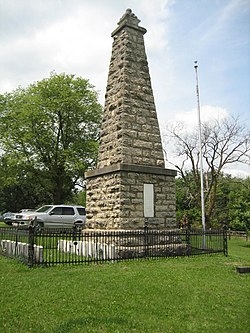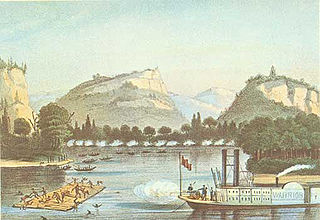
The Battle of Bad Axe, also known as the Bad Axe Massacre, was a battle between Sauk (Sac) and Fox Indians and United States Army regulars and militia that occurred on August 1–2, 1832. This final battle of the Black Hawk War took place near present-day Victory, Wisconsin in the United States. It marked the end of the war between white settlers and militia in Illinois and Michigan Territory, and the Sauk and Fox tribes under warrior Black Hawk.

The Battle of Stillman's Run, also known as the Battle of Sycamore Creek or the Battle of Old Man's Creek, occurred in Illinois on May 14, 1832. The battle was named for the panicked retreat by Major Isaiah Stillman and his detachment of 275 Illinois militia after being attacked by an unknown number of Sauk warriors of Black Hawk's British Band. The numbers of warriors has been estimated that as few as fifty but as many as two hundred participated in the attack. However, reports found in Whitney's Black Hawk War indicated that large numbers of Indians were on the move throughout the region, and it appeared that widespread frontier warfare was underway. The engagement was the first battle of the Black Hawk War (1832), which developed after Black Hawk crossed the Mississippi River from Iowa into Illinois with his band of Sauk and Fox warriors along with women, children, and elders to try to resettle in Illinois. The militia had pursued a small group of Sauk scouts to the main British Band camp following a failed attempt by Black Hawk's emissaries to negotiate a truce.
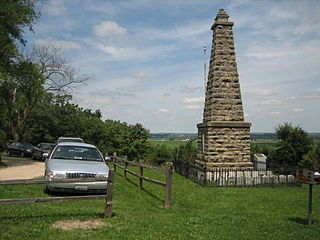
The Battle of Kellogg's Grove is either of two minor battles, or skirmishes, fought during the Black Hawk War in the U.S. state of Illinois, in present-day Stephenson County at and near Kellogg's Grove. In the first skirmish, also known as the Battle of Burr Oak Grove, on June 16, 1832, Illinois militia forces fought against a band of at least 80 Native Americans. During the battle, three militia men under the command of Adam W. Snyder were killed in action. The second battle occurred nine days later when a larger Sauk and Fox band, under the command of Black Hawk, attacked Major John Dement's detachment and killed five militia men.

Samuel Whiteside was an Illinois pioneer. A farmer and backwoodsman, Whiteside briefly served in the Illinois General Assembly after statehood and led the Illinois militia for decades, rising to the rank of general but also enlisting as an ordinary soldier when militia calls declined at the end of wars. Whiteside fought the British in the War of 1812 and Native Americans through the Blackhawk War.

The Buffalo Grove ambush was an ambush that occurred on May 19, 1832 as part of the Black Hawk War. A six-man detail carrying dispatches from United States Colonel James M. Strode at Galena, Illinois to General Henry Atkinson at Dixon's Ferry was ambushed by Native Americans during the attack. William Durley was killed and buried near the site of the ambush. Durley's remains were initially interred by the party that would become victims of the St. Vrain massacre. Two other men had bullet holes in their clothing, but were uninjured. In 1910 the Polo Historical Society moved Durley's remains to a plot beneath a memorial they erected west of Polo, Illinois.
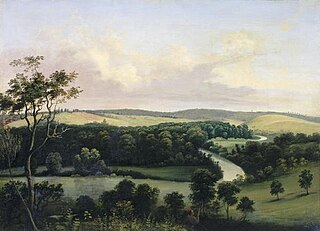
The Battle of Horseshoe Bend, also referred to as the Battle of Pecatonica and the Battle of Bloody Lake, was fought on June 16, 1832 in present-day Wisconsin at an oxbow lake known as "Horseshoe Bend", which was formed by a change in course of the Pecatonica River. The battle was a major turning point in the Black Hawk War, despite being of only minor military significance. The small victory won by the U.S. militia at Horseshoe Bend helped restore public confidence in the volunteer force following an embarrassing defeat at Stillman's Run. The Battle of Horseshoe Bend ended with three militia men killed in action and a party of eleven Kickapoo warriors dead.
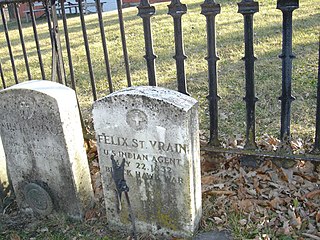
The St. Vrain massacre was an incident in the Black Hawk War. It occurred near present-day Pearl City, Illinois, in Kellogg's Grove, on May 24, 1832. The massacre was most likely committed by Ho-Chunk warriors who were unaffiliated with Black Hawk's band of warriors. It is also unlikely that the group of Ho-Chunk had the sanction of their nation. Killed in the massacre were United States Indian Agent Felix St. Vrain and three of his companions. Some accounts reported that St. Vrain's body was mutilated.
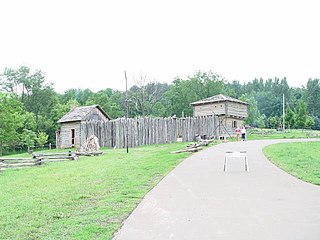
The Battle of Apple River Fort, occurred on the late afternoon of June 24, 1832 at the Apple River Fort, near present-day Elizabeth, Illinois, when Black Hawk and 200 of his "British Band" of Sauk and Fox were surprised by a group of four messengers en route from Galena, Illinois. One of the couriers was wounded in the thigh as the riders quickly made for the protection of the nearby stockade. Courier Fred Dixon lagged behind and provided cover for his comrades. The other couriers rode ahead to warn some 70 settlers of the approaching Sauk and Fox, thus saving their lives. The small company of militia at the fort, about 28-30 men and boys led by Captain Clack Stone, fought off Black Hawk's 150-man war party in an action that lasted about an hour. The withering pace of the gunfire eventually convinced Black Hawk that the fort was too heavily defended to lead a direct attack. He considered burning the fort, then switched to raiding cabins of foodstuffs, clothing and cooking utensils. In the gathering darkness, Black Hawk and his war party retreated.

The Battle of Waddams Grove, also known as the Battle of Yellow Creek was part of the Black Hawk War. It took place in present-day Stephenson County, Illinois on June 18, 1832. After several incidents of Sauk Indian raids on settlers along the Apple River, Captain James W. Stephenson left Galena with a group of volunteer militia in pursuit of the Native party. The group clashed on June 18, 1832 near Yellow Creek and the ensuing battle descended into a bayonet and knife fight in which several Sauk and three militia men were killed. Stephenson was severely wounded by a musketball to the chest during the fighting. The dead were eventually interred in a memorial cemetery in Kellogg's Grove, Illinois where a stone monument was erected in memory of those killed during the war.

Buffalo Grove is an unincorporated community in the Ogle County township of Buffalo, Illinois, United States. It was the first settlement in Ogle County, and was once a bustling frontier town that attracted many of Ogle County's early residents. The creation of the Illinois Central Railroad, caused most of the residents and businesses to move to Polo. Today this former hub of business comprises a few dozen homes.
The Sinsinawa Mound raid occurred on June 29, 1832, near the Sinsinawa mining settlement in Michigan Territory. This incident, part of the Black Hawk War, resulted in the deaths of two men; a third man survived by seeking cover in a nearby blockhouse. In the aftermath of the raid, Captain James W. Stephenson set out to pursue the attackers—a straggling band of Sauk Native Americans—but lost their trail at the Mississippi River. The attack occurred in the same week as other skirmishes and raids, and as a result helped contribute to the growing fear in the region. The raid caused the residents of nearby Platteville to consider fleeing their settlement.
The Plum River raid was a bloodless skirmish that occurred at present-day Savanna, Illinois, on May 21, 1832, as part of the Black Hawk War. Most of the settlement's inhabitants, except for a few defenders, had fled for Galena, Illinois, before the raid happened. A small band of Native Americans, either Sauk or Fox, attacked the settlement while only three of the six defenders were present. The men who were present fell back to the blockhouse and a firefight ensued for about one hour, after which the attackers withdrew. No one was killed or injured during the attack, but in its aftermath Colonel James M. Strode dispatched a detachment of militia to Savanna. They returned to Galena without incident and the settlement at Savanna was temporarily abandoned.
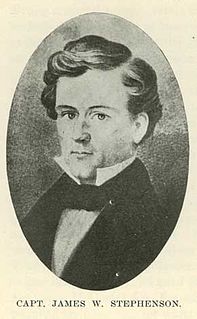
James W. Stephenson was an American militia officer and politician from the state of Illinois. He was born in Virginia but spent most of his youth in Edwardsville, Illinois. In 1825 he was indicted for the murder of a family acquaintance, but never went to trial. Upon the outbreak of the Black Hawk War in 1832, Stephenson raised a company and saw combat, suffering severe wounds at the Battle of Waddams Grove. After the war ended Stephenson entered public life, and served as a member of the Illinois State Senate in 1834. In December 1837 Stephenson was nominated as the Democratic candidate for Governor of Illinois. Within six months of his nomination, accusations of embezzlement were leveled against him, and he was forced to withdraw from the election. In August 1838, Stephenson died at home of tuberculosis.
James D. Henry was a militia officer from the U.S. state of Illinois who rose to the rank of general during the Black Hawk War. Henry was born in Pennsylvania in 1797, and moved to Edwardsville, Illinois in 1822. In 1825, while living in Edwardsville, he was indicted with two other men for the murder of an acquaintance, though he never went to trial. One defendant was tried but found not guilty, and following the trial Henry moved to Springfield, Illinois, where he was elected sheriff. When the Winnebago War broke out in 1827 Henry acted as adjutant for four companies of volunteers.

Waddams Grove, previously known as Wadam's, Waddam's Grove, and Sada, is an unincorporated community in the Stephenson County township of West Point, Illinois, United States. Waddams Grove was the first settlement in Stephenson County. It is located northwest of Lena. The community is near the site of the Battle of Waddams Grove which took place during the Black Hawk War.

The British Band was a mixed-nation group of Native Americans commanded by the Sauk leader Black Hawk, which fought against Illinois and Michigan Territory militias during the 1832 Black Hawk War. The band was composed of about 1,500 men, women, and children from the Sauk, Meskwaki, Fox, Kickapoo, Potawatomi, Ho-Chunk, and Ottawa nations; about 500 of that number were warriors. Black Hawk had an alliance with the British that dated from the War of 1812, giving them their colloquial name. The band crossed the Mississippi River from Iowa into Illinois in an attempt to reclaim their homeland and in violation of several treaties. Subsequently, both the Illinois and Michigan Territory militia were called up and the Black Hawk War ensued.
Yellow Creek is a tributary of the Pecatonica River in Stephenson County, in the US state of Illinois. The 50 mile (80.5 km) stream also flows through a small part of Jo Daviess County. The waters of Yellow Creek were accessed for water quality in 1996, 28 miles (45.1 km) were listed as "fair" and 22 miles (35.4 km) "good." During the 1832 Black Hawk War the Battle of Waddams Grove was fought along Yellow Creek.
After the outbreak of the Black Hawk War, at the Battle of Stillman's Run in May 1832, there were minor attacks and skirmishes throughout the duration of the conflict. The war was fought between white settlers in Illinois and present-day Wisconsin and Sauk Chief Black Hawk. The relatively minor attacks of the war were widely dispersed and often carried out by bands of Native Americans that were unaffiliated with Black Hawk's British Band.
Clack Stone was the elected captain of the “Apple River“ Company, 27th Regiment Illinois Militia during the Black Hawk War of 1832. He was in charge of a company mustered into service in May 1832 from Jo Daviess County, Illinois. Stone's company manned Apple River Fort, a log stockade and blockhouse— a reconstruction of which is located on knoll just east of present-day Elizabeth Stone provided leadership during two war-related incidents. In the first event, some horses were stolen from the fort during the night of June 17, in the prelude to the June 18 action known then as “Stephenson’s Fight.” Today, the fight is erroneously known as the Battle of Waddams Grove. The second event was on the afternoon of June 24: an intense battle known as the Battle of Apple River Fort. After the war, Stone built and operated a general store and helped Redding Bennett, John D. Winters, and others survey and lay out lot lines for the proposed village of Elizabeth. He also owned and apparently operated for a time the “Eagle Saloon” in Galena.
Stone laid claim to numerous land parcels located west of the present village. He remained in today's Jo Daviess County with his common law wife Delilah Hickman for several years, then moved south to Union Grove in what is now Carroll County, Illinois.

Abraham Lincoln served as a volunteer in the Illinois Militia April 21, 1832 – July 10, 1832, during the Black Hawk War. Lincoln never saw combat during his tour but was elected captain of his first company. He was also present in the aftermath of two of the war's battles, where he helped to bury the militia dead. He was mustered in and out of service during the war, going from captain to private and finishing his service in an independent spy company commanded by Captain Jacob Early.
